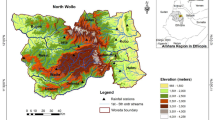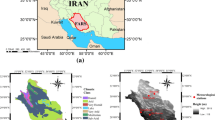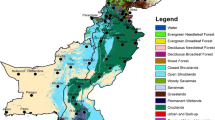Abstract
Drought is the most complex, devastating, slow-onset natural disaster and has recently affected more people than ever before. Remote sensing has recently played a vital role in providing huge amounts of data for monitoring and modeling the incidence of droughts at broad spatiotemporal scales. Therefore, the objective of the current study in Ethiopia’s highlands was to model and map the spatiotemporal patterns, status, and trends of agricultural drought based on the satellite-derived vegetation health index (VHI) on a monthly (June–September) scale from 2004 to 2018. The study used Terra Moderate Resolution Imaging Spectroradiometer (MODIS) Land Surface Temperature and Emissivity 8-Day (MOD11A2) and Enhanced Moderate Resolution Imaging Spectroradiometer Normalized Difference Vegetation Index (eMODIS NDVI) datasets. During data analysis, the VHI, Mann–(MK) Kendall’s trend test, and Sen's slope estimator were used, respectively, to grade agricultural drought, investigate agricultural drought trends, and examine the magnitude of agricultural drought change. Crop yield data for 41 crop growing zones was used to evaluate the capability of VHI for agricultural drought monitoring. The results showed the VHI detected moderate to severe agricultural droughts. Seasonally, 26.3% of the total crop growing areas showed a decreasing VHI trend. In most northern, central, and southeastern Ethiopia, the correlation analyses between VHI and crop yields showed good relationships. The findings of the current study display the importance of mapping the spatiotemporal patterns of agricultural droughts using VHI, aiming at agricultural drought monitoring and establishing early warning and decision-making systems.








Similar content being viewed by others
Data availability statement
The datasets generated and analyzed during the current study are available from the corresponding author on reasonable request.
Abbreviations
- VHI:
-
Vegetation health index
- LST:
-
Land surface temperature
- NDVI:
-
Normalized difference vegetation index
- TCI:
-
Temperature condition index
- VCI:
-
Vegetation condition index
References
Anyamba A, Tucker CJ (2012) Historical perspectives on AVHRR NDVI and vegetation drought monitoring. Remote Sens Drought Innov Monit Approaches. https://doi.org/10.1201/b11863
Baniya B, Tang Q, Xu X, Haile GG, Chhipi-Shrestha G (2019) Spatial and temporal variation of drought based on satellite-derived vegetation condition index in Nepal from 1982–2015. Sensors 19(2):430. https://doi.org/10.3390/s19020430
Bayable G, Gashaw T (2021) Spatiotemporal variability of agricultural drought and its association with climatic variables in the Upper Awash Basin, Ethiopia. SN Appl Sci 3(4):1–20. https://doi.org/10.1007/s42452-021-04471-1
Bayissa YA, Tadesse T, Svoboda M, Wardlow B, Swigart J, Van Andel SJ (2018) Developing a satellite-based combined drought indicator to monitor agricultural drought : a case study for Ethiopia developing a satellite-based combined drought indicator to monitor agricultural drought : a case study for Ethiopia. Giosci Remote Sens 00(00):1–31. https://doi.org/10.1080/15481603.2018.1552508
Beyene EG, Meissner B (2010) Spatio-temporal analyses of correlation between NOAA satellite RFE and weather stations’ rainfall record in Ethiopia. Int J Appl Earth Obs Geoinf 12:S69–S75. https://doi.org/10.1016/j.jag.2009.09.006
Bhaga TD, DubeT SMD, Shoko C (2020) Impacts of climate variability and drought on surface water resources in sub-saharan africa using remote sensing: a review. Remote Sens 12(24):4184
Bhuiyan C, Singh RP, Kogan FN (2006) Monitoring drought dynamics in the Aravalli region (India) using different indices based on ground and remote sensing data. Int J Appl Earth Obs Geoinf 8(4):289–302. https://doi.org/10.1016/j.jag.2006.03.002
Bhuiyan C, Saha AK, Bandyopadhyay N, Kogan FN, Saha AK, Bandyopadhyay N, Analyzing FNK (2017) Analyzing the impact of thermal stress on vegetation health and agricultural drought—a case study from Gujarat, India. Giosci Remote Sens 00(00):1–22. https://doi.org/10.1080/15481603.2017.1309737
Cai S, Zuo D, Xu Z, Han X, Gao X (2018) Spatiotemporal variability and assessment of drought in the Wei River basin of China. In: Proceedings of the international association of hydrological sciences, vol 379, pp 73–82. https://doi.org/10.5194/piahs-379-73-2018
Choi M, Jacobs JM, Anderson MC, Bosch DD (2013) Evaluation of drought indices via remotely sensed data with hydrological variables. J Hydrol 476:265–273. https://doi.org/10.1016/j.jhydrol.2012.10.042
Degefu MA, Bewket W (2015) Trends and spatial patterns of drought incidence in the omo‐ghibe river basin, Ethiopia. Geogr Ann Ser A Phys Geogr 97(2):395–414. https://doi.org/10.1111/geoa.12080
Dinku T, Ayehu GT, Tadesse T, Gessesse B (2018) Validation of new satellite rainfall products over the Upper Blue Nile Basin, Ethiopia. Atmos Meas Tech 11(4):1921–1936. https://doi.org/10.5194/amt-11-1921-2018
Edossa D, Babel M, Das Gupta A (2010) Drought analysis in the Awash River Basin, Ethiopia. Water Resour Manag 24(7):1441–1460. https://doi.org/10.1007/s11269-009-9508-0
Evans JD (1996) Straight forward statistics for the behavioral sciences. Brooks/Cole, Pacific Grove
Frey CM, Kuenzer C, Dech S (2012) Quantitative comparison of the operational NOAA-AVHRR LST product of DLR and the MODIS LST product V005. Int J Remote Sens 33(22):7165–7183. https://doi.org/10.1080/01431161.2012.699693
Frey CM, Kuenzer C (2015) Analysing a 13 years MODIS land surface temperature time series in the Mekong Basin. In: Kuenzer C, Dech S, Wagner W (eds) Remote sensing time series. Remote sensing and digital image processing, vol 22. Springer, Cham. https://doi.org/10.1007/978-3-319-15967-6
Gebrehiwot T, Van der Veen A, Maathuis B (2011) Spatial and temporal assessment of drought in the Northern highlands of Ethiopia. Int J Appl Earth Obs Geoinf 13(3):309–321. https://doi.org/10.1016/j.jag.2010.12.002
Gebrehiwot T, Van der Veen A, Maathuis B (2016) Governing agricultural drought: monitoring using the vegetation condition index. Ethiop J Environ Stud Manag 9(3):354–371
Gidey E, Dikinya O, Sebego R, Segosebe E, Zenebe A (2018) Analysis of the long-term agricultural drought onset, cessation, duration, frequency, severity and spatial extent using vegetation health index (VHI) in Raya and its environs, Northern Ethiopia. Environ Syst Res. https://doi.org/10.1186/s40068-018-0115-z
Gu Y, Brown JF, Verdin JP, Wardlow B (2007) A five-year analysis of MODIS NDVI and NDWI for grassland drought assessment over the central Great Plains of the United States. Geophys Res Lett 34(6):1–6. https://doi.org/10.1029/2006GL029127
Hassan S, Mahmud-ul-islam S (2015) Drought vulnerability assessment in the high barind tract of Bangladesh using MODIS NDVI and land surface temperature (LST) imageries. Int J Sci Res 4(2):55–60
Haile BT, Bekitie KT, Zeleke TT, Ayal DY, Feyisa GL, Anose FA (2022) Drought analysis using standardized evapotranspiration and aridity index at bilate watershed: sub-basins of Ethiopian Rift Valley. Sci World J. https://doi.org/10.1155/2022/1181198
Hayes M, Svoboda M, Wall N, Widhalm M (2011) The Lincoln declaration on drought indices: universal meteorological drought index recommended. Bull Am Meteorol Soc 92(4):485–488. https://doi.org/10.1175/2010BAMS3103.1
Hurni H, Abate S, Bantider A, Debele B (2010) Land degradation and sustainable land management in the Highlands of Ethiopia. In: Hurni H, Wiesmann UM (eds) Global Change and sustainable development: a synthesis of regional experiences from research. Geographica Bernesia, Bern, Switzerland, vol 5, pp 187–207
Ihinegbu C, Ogunwumi T (2021) Multi-criteria modeling of drought: a study of Brandenburg Federal. Model Earth Syst Environ. https://doi.org/10.1007/s40808-021-01197-2
Jenkerson CB, Maiersperger T, Schmidt G (2010) eMODIS: a user-friendly data source. US Geological Survey. Open-File Report 2010–1055, 10 p
Karnieli A, Bayasgalan M, Bayarjargal Y, Agam N, Khudulmur S, Tucker C (2006) Comments on the use of the vegetation health index over Mongolia. Int J Remote Sens 27(10):2017–2024. https://doi.org/10.1080/01431160500121727
Karnieli A, Agam N, Pinker RT, Anderson M, Imhoff ML, Gutman GG, Panov N, Goldberg A (2010) Use of NDVI and land surface temperature for drought assessment: merits and limitations. J Clim 23(3):618–633. https://doi.org/10.1175/2009JCLI2900.1
Katila M, Rajala T, Kangas A (2020) Assessing local trends in indicators of ecosystem services with a time series of forest resource maps. Silva Fennica, 54(4):1–19. https://doi.org/10.14214/sf.10347
Kogan FN (1995) Application of vegetation index and brightness temperature for drought detection. Adv Space Res 15(11):91–100
Kogan FN (2019) Remote sensing for food security. Springer International Publishing, Berlin
Kogan FN, Guo W (2016) Early twenty-first-century droughts during the warmest climate. Geomat Nat Hazards Risk 7(1):127–137. https://doi.org/10.1080/19475705.2013.878399
Kogan FN, Guo W, Yang W, Shannon H (2018) Space-based vegetation health for wheat yield modeling and prediction in Australia. J Appl Remote Sens 12(2):026002. https://doi.org/10.1117/1.JRS.12.026002
Kogan FN, Guo W, Yang W (2019) Drought and food security prediction from NOAA new generation of operational satellites. Geomat Nat Hazards Risk 10(1):651–666. https://doi.org/10.1080/19475705.2018.1541257
Li B, Zhang J, Yu Z, Liang Z, Chen L, Acharya K (2017) Climate change is driven water budget dynamics of a Tibetan inland lake. Glob Planet Change 150:70–80. https://doi.org/10.1016/j.gloplacha.2017.02.003
Liou YA, Mulualem GM (2019) Spatiotemporal assessment of drought in Ethiopia and the impact of recent intense droughts. Remote Sens 11(15):1828. https://doi.org/10.3390/rs11151828
Lu J, Carbone GJ, Gao P (2017) Agricultural and forest meteorology detrending crop yield data for spatial visualization of drought impacts in the United States, 1895–2014. Agric for Meteorol 237–238:196–208. https://doi.org/10.1016/j.agrformet.2017.02.001
Ma’rufah U, Hidayat R, Prasasti I (2017) Analysis of relationship between meteorological and agricultural drought using standardized precipitation index and vegetation health index. J Phys Conf Ser. https://doi.org/10.1088/1742-6596/755/1/011001
Mann HB (1945) Nonparametric tests against trend. Econometrica. https://doi.org/10.2307/1907187
Miah MG, Abdullah HM, Jeong C (2017) Exploring standardized precipitation evapotranspiration index for drought assessment in Bangladesh. Environ Monit Assess. https://doi.org/10.1007/s10661-017-6235-5
Mishra AK, Singh VP (2010) A review of drought concepts. J Hydrol 391(1–2):202–216
Mishra D, Goswami S, Matin S, Sarup J (2022) Analyzing the extent of drought in the Rajasthan state of India using vegetation condition index and standardized precipitation index. Modeling Earth Syst Environ 8(1):601–610. https://doi.org/10.1007/s40808-021-01102-x
Mohammed Y, Yimer F, Tadesse M, Tesfaye K (2018) Meteorological drought assessment in Northeast Highlands of Ethiopia. Int J Clim Change Strateg Manag 10:142–160. https://doi.org/10.1108/IJCCSM-12-2016-0179
Mutsotso RB, Sichangi AW, Makokha GO (2018) Spatio-temporal drought characterization in Kenya from 1987 to 2016. Adv Remote Sens 7:125–143. https://doi.org/10.4236/ars.2018.72009
Nam WH, Hayes MJ, Svoboda MD, Tadesse T, Wilhite DA (2015) Drought hazard assessment in the context of climate change for South Korea. Agric Water Manag 160:106–117. https://doi.org/10.1016/j.agwat.2015.06.029
Neeti N, Eastman JR (2011) A contextual Mann–Kendall approach for the assessment of trend significance in image time series. Trans GIS 15:599–611. https://doi.org/10.1111/j.1467-9671.2011.01280.x
Patil Abhijit S, Patil Akshay A, Patil Somnath P, Saundade Sushant D, Chugule Kusum A, Katavare Shital B, Panhalkar Sachin S (2021) Analysis of the agriculture drought severity and spatial extent using Vegetation Health Index (VHI) in Manganga watershed of Maharashtra, India
Pérez-Hoyos A, Rembold F, Kerdiles H, Gallego J (2017) Comparison of global land cover datasets for cropland monitoring. Remote Sens. https://doi.org/10.3390/rs9111118
Pohlert T (2020) Trend: non-parametric trend tests and change-point detection. R package v.1.1.2. https://cran.r-project.org/package=trend
Qian X, Liang L, Shen Q, Sun Q (2016) Drought trends based on the VCI and its correlation with climate factors in the agricultural areas of China from 1982 to 2010. Environ Monit Assess. https://doi.org/10.1007/s10661-016-5657-9
Qu C, Hao X, Qu JJ (2019) Monitoring extreme agricultural drought over the Horn of Africa (HOA) using remote sensing measurements. Remote Sens 11(8):902
Rahman MR, Lateh H (2016) Meteorological drought in Bangladesh: assessing, analyzing and hazard mapping using SPI, GIS, and monthly rainfall data. Environ Earth Sci. https://doi.org/10.1007/s12665-016-5829-5
Sai MS, Murthy CS, Chandrasekar K, Jeyaseelan AT, Diwakar PG, Dadhwal VK (2016) Agricultural drought: assessment and monitoring. Mausam 67(1):131–142
Segele ZT, Lamb PJ (2005) Characterization and variability of Kiremt rainy season over Ethiopia. Meteorol Atmos Phys 89(1):153–180. https://doi.org/10.1007/s00703-005-0127-x
Sen PK (1968) Estimates of the regression coefficient based on Kendall’s tau. J Am Stat Assoc 63(324):1379–1389
Singh RP, Kogan FN, Oceanic N (2003) Vegetation and temperature condition indices from NOAA AVHRR data for drought monitoring over India. Int J Remote Sens 24(22):4393–4402. https://doi.org/10.1080/0143116031000084323
Sohnesen TP (2020) Two sides to the same drought: measurement and impact of Ethiopia’s 2015 historical drought. Econ Disasters Clim Change 4(1):83–101. https://doi.org/10.1007/s41885-019-00048-w
Swets DL (1999) A weighted least-squares approach to temporal smoothing of NDVI. In: Proceedings of the 1999 ASPRS annual conference, from image to information, Portland. American society for photogrammetry and remote sensing, Bethesda, 17–21 May 1999
Tadesse T, Sena GB, Berhan G, Regassa T (2015) Evaluating a satellite-based seasonal evapotranspiration product and identifying its relationship with other satellite-derived products and crop yield: a case study for Ethiopia. Int J Appl Earth Obs Geoinf 40:39–54. https://doi.org/10.1016/j.jag.2015.03.006
Tucker CJ (1979) Red and photographic infrared linear combinations for monitoring vegetation. Remote Sens Environ 8(2):127–150. https://doi.org/10.1016/0034-4257(79)90013-0
Vicente-Serrano SM, Beguería S, López-Moreno JI (2010) A multiscalar drought index sensitive to global warming: the standardized precipitation evapotranspiration index. J Clim 23(7):1696–1718. https://doi.org/10.1175/2009JCLI2909.1
Viste E, Korecha D, Sorteberg A (2013) Recent drought and precipitation tendencies in Ethiopia. Theor Appl Climatol 112(3):535–551. https://doi.org/10.1007/s00704-012-0746-3
Wan Z (2006) MODIS land surface temperature products users’ guide. Institute for Computational Earth System Science, University of California, Santa Barbara, p 805
Wilhite DA (2011) Quantification of agricultural drought for effective drought mitigation and preparedness: key issues and challenges. In: Agricultural drought indices: Proceedings of the WMO/UNISDR expert group meeting, 2–4 June 2010, Murcia, Spain. World Meteorological Organization (WMO), Geneva, pp 13–21
Wu Z, Huang NE, Long SR, Peng CK (2007) On the trend, detrending, and variability of nonlinear and nonstationary time series. Proc Natl Acad Sci USA 104(38):14889–14894
Yisehak B, Zenebe A (2020) Modeling multivariate standardized drought index based on the drought information from precipitation and runoff: a case study of Hare watershed of Southern Ethiopian Rift Valley Basin. Model Earth Syst Environ. https://doi.org/10.1007/s40808-020-00923-6
Zeng J, Zhang R, Qu Y, Bento VA, Zhou T, Lin Y, Wu X, Qi J, Shui W, Wang Q (2022) Improving the drought monitoring capability of VHI at the global scale via ensemble indices for various vegetation types from 2001 to 2018. Weather Clim Extremes 35:100412. https://doi.org/10.1016/j.wace.2022.100412
Acknowledgements
This research was undertaken with financial support from the Federal Ministry of Economic Cooperation and Development (Bundesministerium für wirtschaftliche Zusammenarbeit und Entwicklung, BMZ).
Author information
Authors and Affiliations
Contributions
ZC initiates the research topic, conducts a literature review, designs scientific techniques, collects data, analyzes it, and interprets it, prepares draft manuscripts for publication. AA, LT, and WA provide feedback on the research idea, provide advice on the overall research activities, and improve the manuscript. All of the authors provided their in-depth knowledge of the study. The final manuscript was read and approved by all authors.
Corresponding author
Ethics declarations
Conflict of interest
The authors declare that they have no known competing financial interests or personal relationships that could have appeared to influence the work reported in this paper.
Additional information
Publisher's Note
Springer Nature remains neutral with regard to jurisdictional claims in published maps and institutional affiliations.
Rights and permissions
About this article
Cite this article
Chere, Z., Abegaz, A., Tamene, L. et al. Modeling and mapping the spatiotemporal variation in agricultural drought based on a satellite-derived vegetation health index across the highlands of Ethiopia. Model. Earth Syst. Environ. 8, 4539–4552 (2022). https://doi.org/10.1007/s40808-022-01439-x
Received:
Accepted:
Published:
Issue Date:
DOI: https://doi.org/10.1007/s40808-022-01439-x




